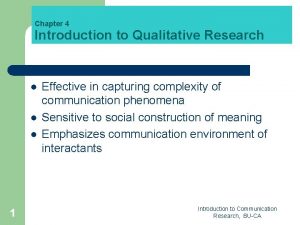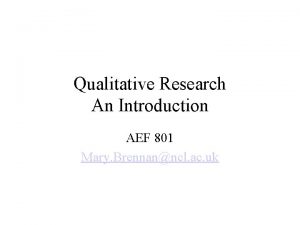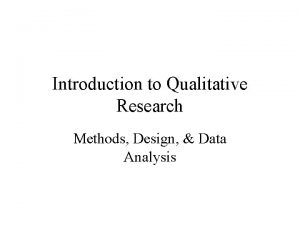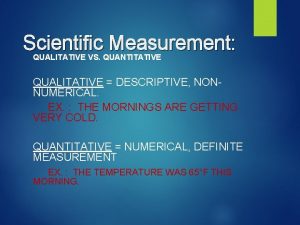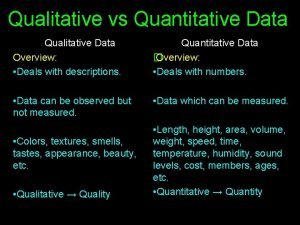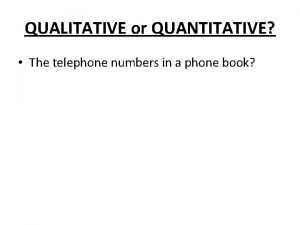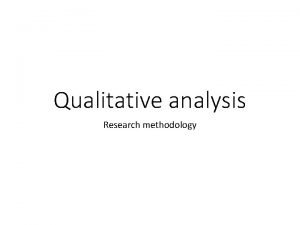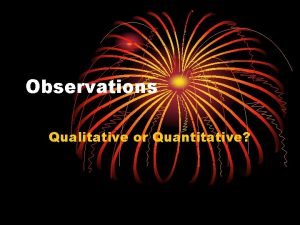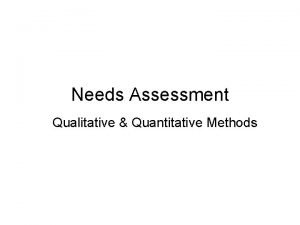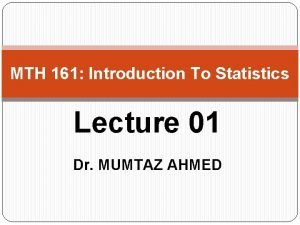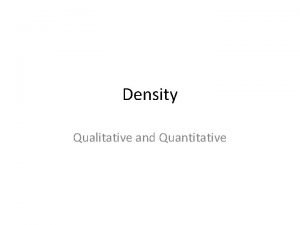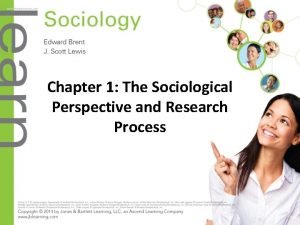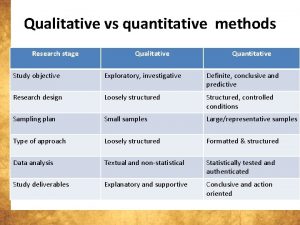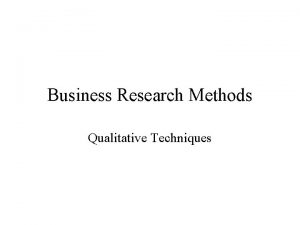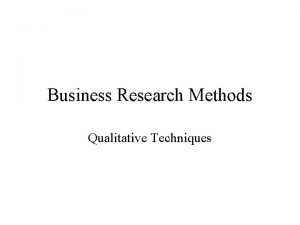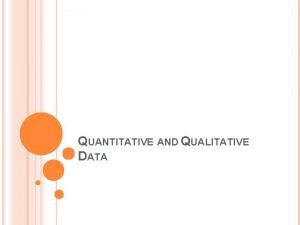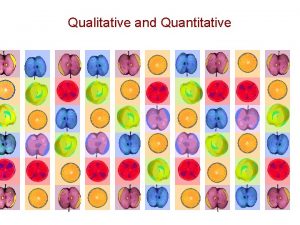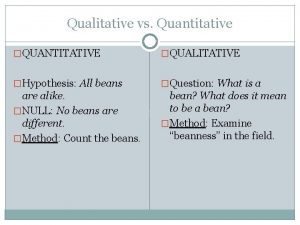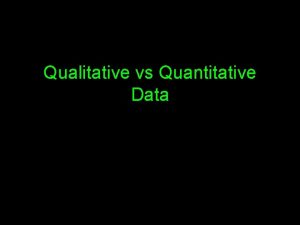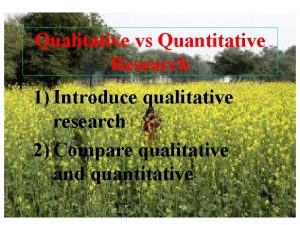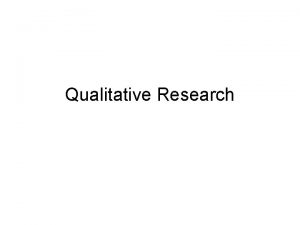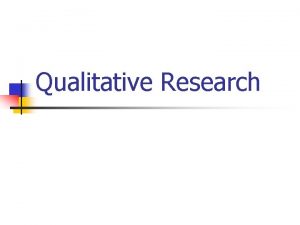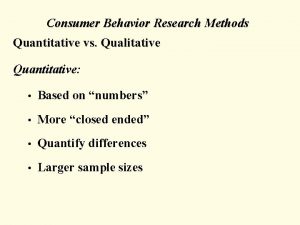Qualitative Research Versus Quantitative Research Qualitative Versus Quantitative

























- Slides: 25

Qualitative Research Versus Quantitative Research

Qualitative Versus Quantitative Research Qualitative Research "All research ultimately has a qualitative rounding” - Donald Campbell Quantitative Research There's no such thing as qualitative data. Everything is either 1 or 0”- Fred Kerlinger The two quotes are from Miles & Huberman (1994, p. 40). Qualitative Data Analysis)

What is Quantitative Research Quantitative research uses statistical methods. It typically begins with the collection of data based on a theory or hypothesis, followed by the application of statistical methods. Causal relationships are studied by manipulating factors thought to influence the phenomena of interest while controlling other variables relevant to the experimental outcomes. .

Quantitative Methods Quantitative methods are research methods dealing with numbers and anything that is measurable. Counting and measuring are common forms of quantitative methods. They are therefore to be distinguished from qualitative methods. These are often presented in tables, graphs or other forms of statistics

Distinguishing Features Aim The aim is a complete, detailed description. The aim is to classify features, count them, and construct statistical models in an attempt to explain what is observed. What does the Researcher know Researcher may only know roughly in advance what he/she is looking for. Researcher knows clearly in advance what he/she is looking for. When do we recommend Recommended during earlier phases of research projects. Recommended during latter phases of research projects. Research Design The design emerges as the study unfolds. All aspects of the study are carefully designed before data is collected.

Contd… Form of Data is in the form of words, pictures or objects. Data is in the form of numbers and statistics. Nature Subjective - individuals’ interpretation of events is important , e. g. , uses participant observation, in-depth interviews etc. Objective – seeks precise measurement & analysis of target concepts, e. g. , uses surveys, questionnaires etc. Contd………. .

Contd……. Qualitative data is more 'rich', time consuming, and less able to be generalized. Quantitative data is more efficient, able to test hypotheses, but may miss contextual detail. Researcher tends to become subjectively immersed in the subject matter. Researcher tends to remain objectively separated from the subject matter.

Which methods do you use? Depends on your research The objective of your research Central question Time Type of access (are people willing to work with you, do you have permission. Do you have a room to conduct interviews, for example?

Usage of these Methods In most physical and biological sciences, the use of either quantitative or qualitative methods is uncontroversial, and each is used when appropriate. Advocates of quantitative methods argue that only by using such methods can the social sciences become truly scientific; advocates of qualitative methods argue that quantitative methods tend to obscure the reality of the social phenomena under study because they underestimate or neglect the non-measurable factors, which may be the most important.

Usage of these Methods The modern tendency (and in reality the majority tendency throughout the history of social science) is to use combination of approaches. Quantitative methods might be used with a global qualitative frame. Qualitative methods might be used to understand the meaning of the numbers produced by quantitative methods. Using quantitative methods, it is possible to give precise and testable expression to qualitative ideas.

Main Types of Qualitative Research Case study Attempts to shed light on a phenomena by studying in-depth a single case example of the phenomena. The case can be an individual person, an event, a group, or an institution.

Field Research Field research can also be considered either a broad approach to qualitative research or a method of gathering qualitative data. The researcher goes "into the field" to observe the phenomenon in its natural state or in situ. As such, it is probably most related to the method of participant observation. The field researcher typically takes extensive field notes which are subsequently coded analyzed in a variety of ways.

Qualitative Data Collection & Analysis Interactive interviewing: People asked to verbally describe their experiences of phenomenon. Written descriptions by participants: People are asked to write descriptions of their experiences of phenomenon. Observation: Descriptive observations of verbal and non-verbal behaviour.

Case Study The basic objective of the case study method is to confront the student with a real life situation. The validity of the case study approach is directly related to the reality which the cases have demonstrated. An important principle to be used in the use case study method is the necessity for trying to formulate specific solutions and analysis once the real problems have been identified.

Ethnography Focuses on the sociology of meaning through close field observation of socio-cultural phenomena. Typically, the ethnographer focuses on a community. The ethnographer becomes immersed in the culture as an active participant and records extensive field notes.

Benefit of Ethnography Facilitates zooming in into particular aspects, relations or phenomenon in the setting without losing sight of the whole Enables the researcher to understand the culture through the interpretations, experiences and perceptions and meanings given by those living within this specific cultural context.

Natural Setting Research is done in the unpredictable, chaos of the natural setting. ……… :

Observation in qualitative research Holistic From a Distance To become familiar with the research setting Forces you to use your senses

Non-Participant Observation

Participant Observation Gaze”is the act of seeing; it is an act of selective perception. Much of what we see is shaped by our experiences, and our “gaze”has a direct bearing on what we think. And what we see and think …has a bearing upon what we say and what and how we write. Paul Stoller

Fieldnotes during observation Try to write down as much as you can. Much description so that you can make a verbal photo, so that someone can feel as if they were there even if they weren’t. Try to be as explicit as possible. Avoid aggregate observations ( Many people came inside)

Thick versus Thin description Thin Description A group of students ran down the hall while a few others walked. The next class was in afternoon. Thick Description: A group of ten students (4 girls and 6 boys) were going to their next class. The next class began at one o’clock. It was five to one. One of the girls and four of the boys were running. Three girls were had high heels on and walked at a brisk pace, while a young man walked slowly behin him because he was using crutches.

Characteristics of good qualitative researchers Comfortable with ambiguity Are highly intuitive in that they are sensitive to context (physical settings and people, overt and covert agendas, verbal and nonverbal behaviours) Are able to live with long periods of boredom

(cont) Have a keen sense of timing, particularly in interviews able to establish rapport with others empathetic excellent listeners Aren’t easily embarrassed or judgmental extremely well-organized e good writers who can describe phenomena clearly and in interesting detail self-critical, self-analytical, and are capable of detachment

Think Over: In what ways are the questions of a qualitative researcher different to those of a journalist? What other information does a qualitative researcher need to answer the question: What is going on here--- in this Lecture Hall ? How can he get this information?
 Quantitative research words
Quantitative research words To understand and interpret social interactions
To understand and interpret social interactions Similarities between qualitative and quantitative research
Similarities between qualitative and quantitative research Similarities between qualitative and quantitative research
Similarities between qualitative and quantitative research Sampling methods in qualitative and quantitative research
Sampling methods in qualitative and quantitative research Site:slidetodoc.com
Site:slidetodoc.com Quantitative vs. qualitative
Quantitative vs. qualitative Methodology triangulation
Methodology triangulation What is research design in qualitative research
What is research design in qualitative research Chapter 3 research instrument example
Chapter 3 research instrument example Qualitative research design
Qualitative research design Is a bipolar survey qualitative or quantitative
Is a bipolar survey qualitative or quantitative What is holistic in research
What is holistic in research Longitudinal study qualitative or quantitative
Longitudinal study qualitative or quantitative Qualitative vs quantitative measurements
Qualitative vs quantitative measurements What is qualitative data
What is qualitative data Qualitative data biology
Qualitative data biology Telephone number qualitative or quantitative
Telephone number qualitative or quantitative Difference between qualitative and quantative data
Difference between qualitative and quantative data Definition of qualitative and quantitative observations
Definition of qualitative and quantitative observations Difference between qualitative and quantitative
Difference between qualitative and quantitative Qualitative variables and quantitative variables
Qualitative variables and quantitative variables Qualitative und quantitative differenzierung
Qualitative und quantitative differenzierung Is density a quantitative or qualitative property
Is density a quantitative or qualitative property Data analysis qualitative and quantitative
Data analysis qualitative and quantitative Qualitative vs quantitative sociology
Qualitative vs quantitative sociology



